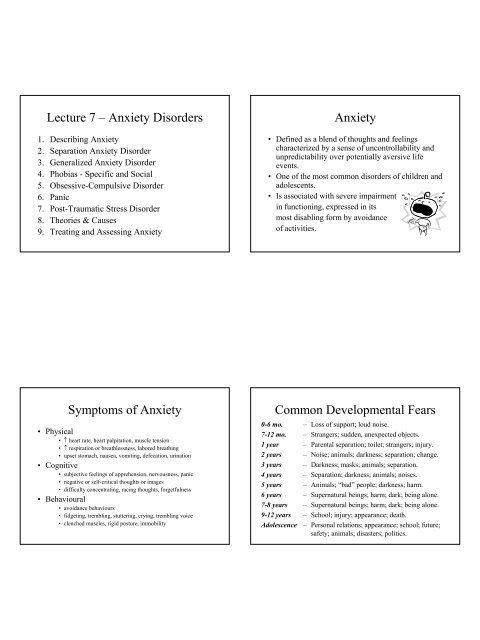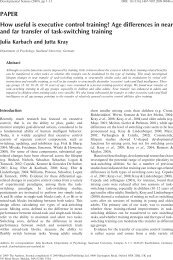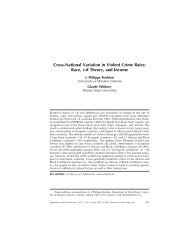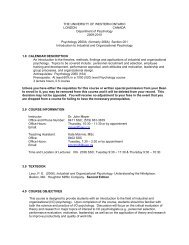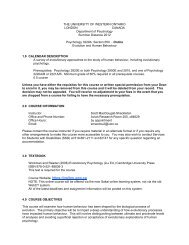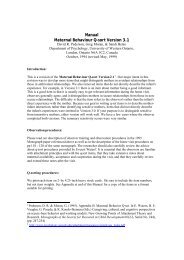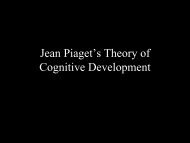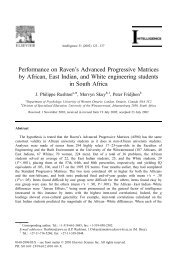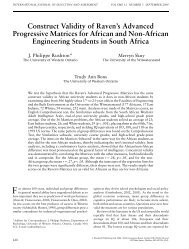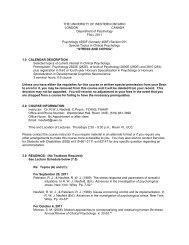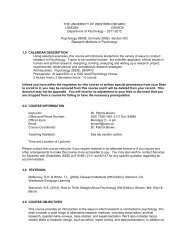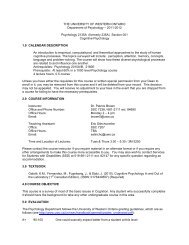Lecture 7 â Anxiety Disorders Anxiety Symptoms of ... - Psychology
Lecture 7 â Anxiety Disorders Anxiety Symptoms of ... - Psychology
Lecture 7 â Anxiety Disorders Anxiety Symptoms of ... - Psychology
Create successful ePaper yourself
Turn your PDF publications into a flip-book with our unique Google optimized e-Paper software.
Generalized <strong>Anxiety</strong> Disorder• Chronic or exaggerated worry with an almostconstant anticipation <strong>of</strong> disaster withoutprovocation.• Often accompanied by physical symptoms.• Apprehensive Expectation - worry when there isno cause or even if contradictory evidence exists.• Highly prevalent, 3% to 14% <strong>of</strong> all children.• Often co-morbid with other anxiety disorders anddepression.• Age <strong>of</strong> Onset about 10 to 14 yearsSpecific Phobias• Extreme, disabling fear <strong>of</strong> specific objects orsituations that pose little or no danger• Often leads to avoidance or disrupted routines• Child may not realize the fear is extreme andunreasonable• 5 DSM-IV subtypes: animal, natural environment,blood-injection-injury, situational, “other”• 2-4% <strong>of</strong> children• Peak onset between ages 10 and 13Social Phobias• Marked, persistent fear <strong>of</strong> being the focus<strong>of</strong> attention, or doing somethinghumiliating• Children with social phobias more likelyto be highly emotional, socially fearfuland inhibited, sad, and lonely• 1-3% <strong>of</strong> children, slightly more girls• Age <strong>of</strong> onset <strong>of</strong>ten early to midadolescence(with exaggerated self-focus)• Selective mutism may be a form <strong>of</strong> socialphobiaObsessive-Compulsive Disorder• Obsessions - persistent and intrusive thoughts.• Compulsions - repetitive, purposeful behaviours,intended to neutralize or reduce anxiety.• Most common obsessions: germs andcontamination; fears <strong>of</strong> harm to self or others;concerns with symmetry; moralization.• Prevalence: about 2-3% <strong>of</strong> all children, morecommon in young boys than girls.• Highly co-morbid with other anxiety disorders,depression, and disruptive behaviour disorders.
Panic & Panic Disorder• Panic attack: a sudden and overwhelmingperiod <strong>of</strong> intense fear or discomfortaccompanied by the flight/fight response• Panic disorder: recurrent unexpected panicattacks, as well as persistent concern aboutthe possible implications and consequences<strong>of</strong> having another attack• Agoraphobia: fear and avoidance <strong>of</strong>situations/ places where a panic attack is feltlikely to occur.Post-Traumatic Stress Disorder• Persistent anxiety following exposure to aseverely traumatizing event (e.g. actual orthreatened death or injury, major accidents,natural disasters, abuse).• Core features:1. Persistent re-experiencing <strong>of</strong> the traumatic event.2. Avoidance <strong>of</strong> stimuli associated with the trauma andnumbing <strong>of</strong> general responsiveness.3. Persistent symptoms <strong>of</strong> over-arousal.• PTSD is correlated with degree <strong>of</strong> exposure.Theories and Causes• Biology and Heritablity:– Inherited biological vulnerabilities towards anxiety.– Involvement <strong>of</strong> various areas <strong>of</strong> the brain in theexperience <strong>of</strong> anxiety and panic.• Temperament and Family Influences:– Is infant temperament related to later anxietyproblems?• Learning theory:– Fear is learned through classical conditioning andmaintained by operant conditioning.
Treatment• Directed at modifying 4 primary problems:• 1. Excessive escape and avoidance behaviours.• 2. Emergency physiological reactions to perceived threats.• 3. Sense <strong>of</strong> a lack <strong>of</strong> control.• 4. Distorted information processing.• Behavioural Treatments• exposure, systematic desensitization, modeling.• Cognitive-Behavioural Treatments• how to modify maladaptive thought patterns• Medication


